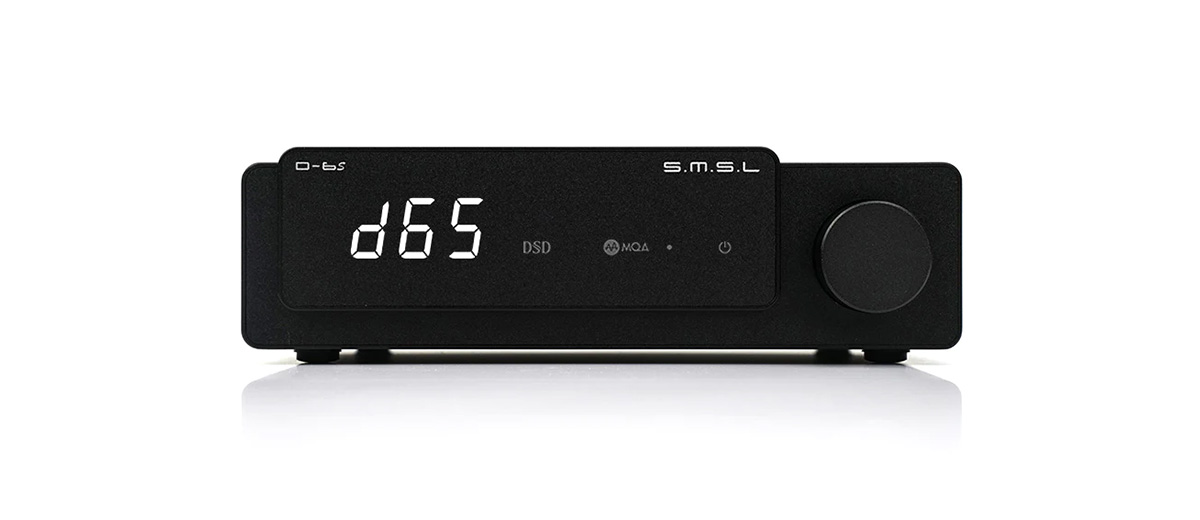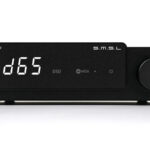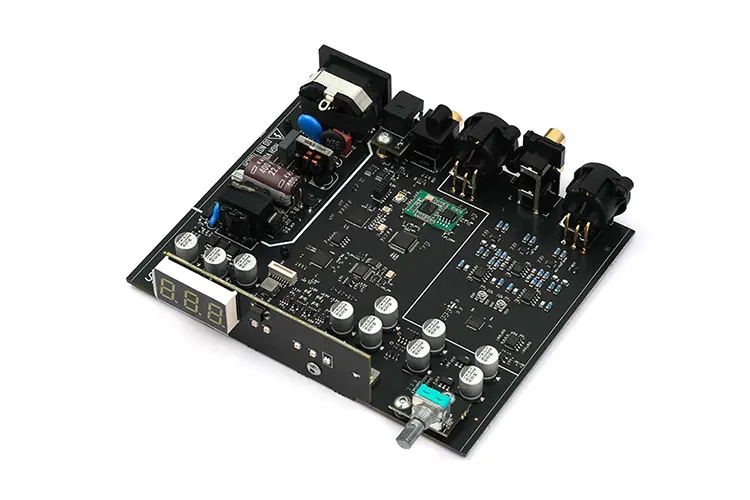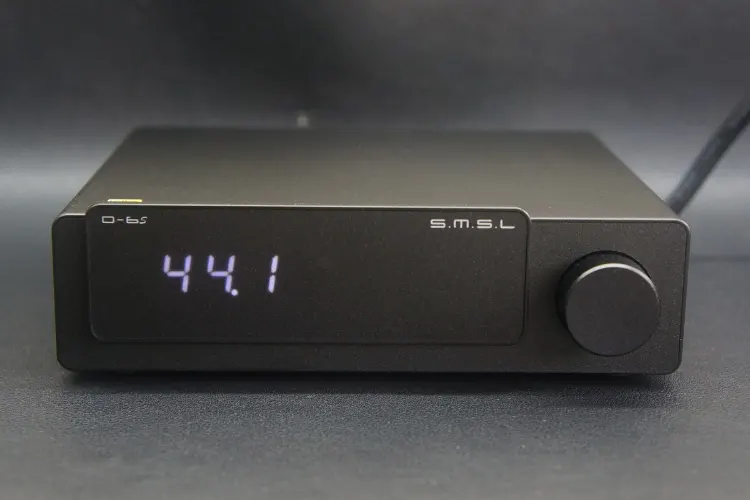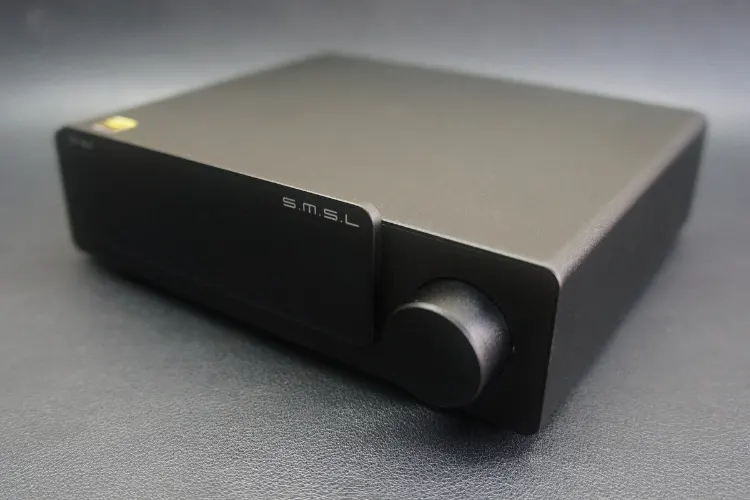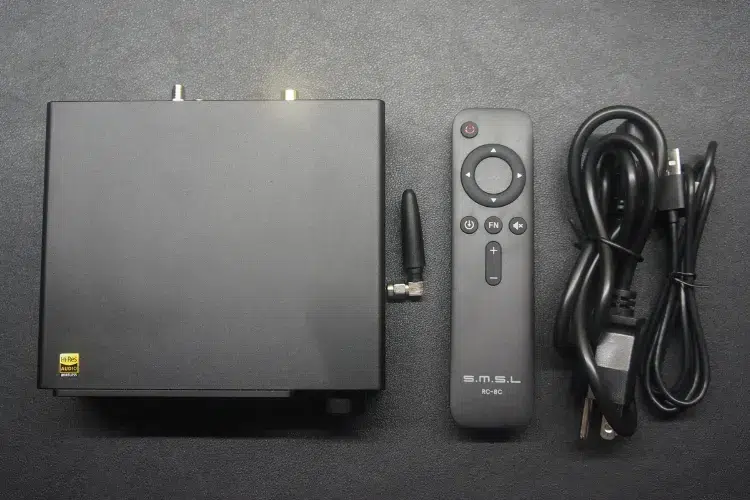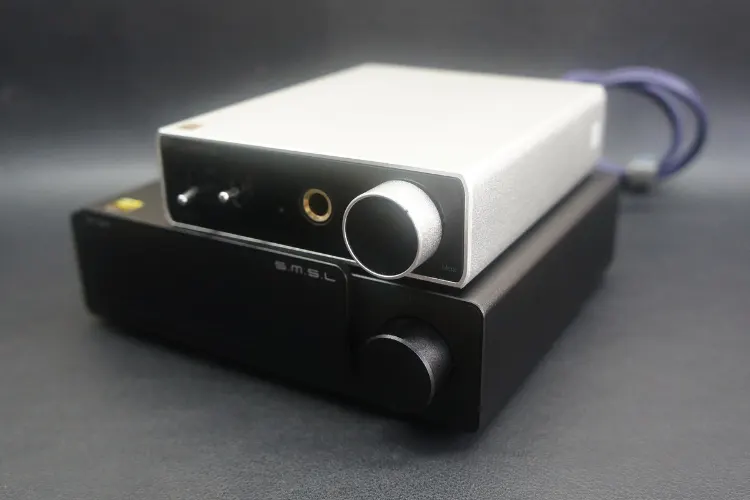We review the SMSL D-6S, which is a compact desktop digital-to-analog converter equipped with an ES9039Q2M DAC, BT5.1, and MQA decoding capability. It is priced at $199.
Disclaimer: This sample was sent to us for our honest opinion. Headfonics is an independent website with no affiliate links or partnerships. We thank Shenzhen Audio and SMSL for their support.
Click here to learn more about SMSL products that we have previously featured on Headfonics.
Note, that this article follows our latest scoring guidelines which you can find in more detail here.
SMSL’s latest compact desktop digital wonder is the D-6S. This is a stand-alone desktop DAC with some of the latest Sabre chipset technology and in true SMSL fashion, it is very reasonably priced at $199.
Integrating MQA decoding and Bluetooth connectivity, the D-6S certainly has a very interesting value proposition. We compare it to the likes of the iFi Audio ZEN DAC and SMSL entry-level SU-1 to see if it has what it takes to be your next affordable DAC.
Tech Highlights
The SMSL D-6S is a dedicated desktop digital-to-analog converter with RCA and XLR outputs, as well as Bluetooth, optical, and coaxial inputs.
The D-6S uses the third-generation XMOS XU-316 USB processor, providing a stable and low-latency USB connection. The XMOS chip works in unison with an ESS ES9039Q2M, letting it decode up to PCM 32-bit/768kHz and DSD512 formats.
As mentioned previously, the D-6S supports Bluetooth input, specifically, Bluetooth 5.1 with wide codec support. This allows you to stream wireless audio from your smartphone, tablet, or laptop whilst minimizing wireless latency and maximizing wireless fidelity and compatibility.
Lastly, the D-6S supports MQA (Master Quality Authenticated) decoding technology, delivering high-fidelity in a smaller file size.
Design
The D-6S has a sleek and minimalist design, letting it easily blend in aesthetically with most desktop setups. The chassis is made of aluminum alloy and has a matte black finish.
All edges and corners are filleted and chamfered, making it pleasing to the touch. My only gripe is the sharp corners of the front panel display. It does break the otherwise plain design of the unit, but I did find my finger getting caught on its sharp edges.
The front panel has frosted plastic that reveals a 7-segment LED display that shows the input source, sample rate, and volume level. The only button on the front panel is the power button, which also doubles as the input selector.
The display has a soft white backlight that is not too bright or distracting but sufficiently displays all pertinent information even in a bright room.
Coming in at 150x42x128.5mm and 590g, it isn’t the smallest DAC unit and will take up some desktop space, but it isn’t too large to cause any problems even in smaller dorm room setups.
When connected to a larger home theater or TV setup, the larger size becomes a non-issue, and the D-6S will easily blend into even the most minimalist Hi-Fi setups.
I/O
Despite the unit’s minimalist utilitarian design, it does not skimp out when it comes to its input options. The unit sports a USB-C input, a Toslink optical input, a Coaxial digital input, a Bluetooth antenna, and a 100-240v 3-prong AC power input.
This is a comprehensive suite of inputs especially at a sub-200 USD price point, enabling this DAC to be a hub of a system with multiple digital sources such as streamers, computers, CD players, and even smartphones and tablets via its Bluetooth input.
While we’re on the topic of CD players, it would also be important to note that the D-6S is also capable of decoding MQA CDs, ensuring that audiophiles who are invested in the CD format are sufficiently covered.
The USB input on the back panel supports Windows 7/8/8.1/10/11 once the automatic installation of the drivers concludes, as well as Mac OS X10.6+, Linux (driverless), Android, and iOS devices.
Decoding is up to PCM 32-bit/768kHz and DSD512 formats, as well as the previously mentioned MQA and MQA-CD unfolding.
On the other hand, the Bluetooth input supports aptX HD, aptX, LDAC, AAC, and SBC codecs. Additionally, The coaxial and optical inputs support PCM up to 24bit/192kHz and DSD64 (DoP)
As for its outputs, the D-6S comes with both XLR output and RCA output. Through its balanced XLR out, the D-6S has an output of 5Vrms and a dynamic range of 129dB. Through its RCA output, it has an output of 2.5Vrms and a dynamic range of 126dB.
Controls
The D-6S has a simple and intuitive control scheme that is easy to operate. The power button on the front panel can be used to turn on/off the device and switch between the four inputs.
A short press will open the source selection menu, where turning the volume knob will cycle through the 4 input sources.
Successive short presses of the volume knob will enter the filter menu, DPLL menu, and backlight menu, wherein turning the volume knob cycles through the options in each menu. In normal operation, the LED display will show the sample rate of the file being decoded.
The remote control can be used to adjust the volume, mute, switch inputs, and change the digital filter settings. The volume buttons can increase or decrease the output level by steps of 1 from 1-99, while the mute button can toggle the mute function.
Packaging & Accessories
The D-6S comes in a simple cardboard box that has the SMSL logo and model name on the front. The box contains the following items: The D-6S DAC, power cord, USB-A to USB-C Cable, Bluetooth antenna, Remote Control, User manual, and warranty card.
The accessories are basic but sufficient for the operation of the device. The power cord and USB cable are of decent quality and length.
The Bluetooth antenna is easy to install and has a flexible joint that allows you to adjust the angle. The remote control is small and handy but requires two AAA batteries that are, unfortunately, not included.
Sound Impressions
All testing was done with a Topping L30 II amplifier, paired with the Sennheiser HD 580 Precision, and Modhouse Argon MK3 headphones, as well as the Moondrop Blessing 3 IEMs.
Summary
The D-6S is a neutral-sounding DAC that has an exciting and dynamic sound signature. It is well-extended with a good dynamic range, presenting complicated arrangements with no vagueness whatsoever.
The unit has average good performance alongside above-average imaging performance. Its neutral and exciting tonality makes it pair well with neutral-sounding amps.
Timbre
The D-6S has a clean but engaging timbre that does not color the overall tonal balance at all, It does not add any warmth or brightness to the sound but rather preserves its original tonality while adding some excitement via its good dynamics.
Low-end bass drum hits are not given any additional weight and bass riffs do not bleed into the lower mids. Despite this, deep male vocals do not sound hollow due to the DAC’s good extension towards the low end.
Bass hits have a strong impact and good texture. The difference in texture was quite noticeable when compared to other less capable DACs.
The mid-range was neutral but exciting. String instruments are well articulated and textured, and vocal performances are presented in a way that maintains all nuance. Once again, the sheer texture playback was the immediate standout to me.
High-pitched female vocals are presented with a slight sparkle, giving a better sense of detail. The treble region is presented in a very detailed manner. Different cymbal strikes can be easily differentiated from one another, but it does not introduce any sibilance in its presentation.
Snare drums sounded full and nuanced, compared to the compressed “crunchy” snare drum playback I observed in other more affordable DACs.
Despite this, the high end was the only part of the frequency response that did not wow me. Don’t get me wrong, its performance is fine, but nothing I heard on the high end made me feel that it was unequivocally better than the DACs I’ve tried before.
Staging and Dynamics
The D-6S has an impressive dynamic range, contributing to the exciting and dynamic sound signature of the unit. The first thing that stood out once I started using the SU-1 was how much livelier all sounds in the mix came off as.
The sheer volume difference between the loudest and softest instruments within a mix gives the music a more natural yet engaging tonality. It contributes to the feeling that the band is playing right in front of you, instead of listening to a recorded track through some headphones.
This improvement is better observed in tracks with complex arrangements and multiple layers. Other less capable DACs may present different layers in a way that makes them sound like a solid wall of sound, but the D-6S make each layer easily distinguishable from one another.
The D-6S’s staging performance is quite good, giving tracks a more atmospheric sound, especially in lower-end rumbles and bass riffs.
It has accurate imaging and positioning that place the instruments and vocal locations precisely in the space. There is no sense of vagueness and individual instruments can be easily isolated.
Click on page 2 below for our recommended pairings and selected comparisons.

